how to extract harmalas for syrian rue seeds
Posted by Erik of Bounty botanicals on May 16th 2024
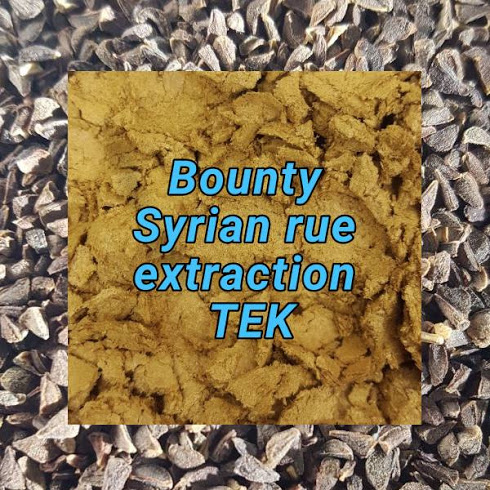
Hello!
I would like to start off by saying this extraction procedure is intended for educational purposes only.
In this tutorial we'll be discussing how to extract and separate harmine and harmaline from Syrian rue seeds using food safe materials only. This TEK isn't anything new really, but does contain tips and tricks to make a great extract while reducing frustrations :) Well, let's jump in shall we?
THE CHEMICALS:
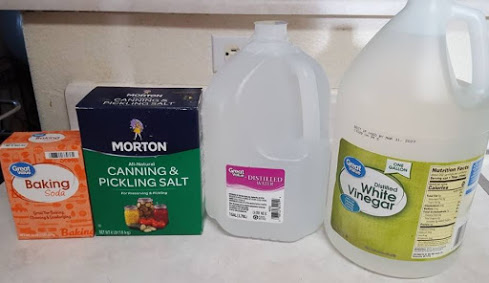
First, let's go over the chemicals needed to extract the harmalas: 1. Sodium bicarbonate(baking soda) 2.Sodium carbonate (This can be made from baking soda by heating in the oven at 400 F for 30 min. or so) 3.Distilled vinegar(citric acid can also be used) 4.Plain salt with no other additives 5.Distilled water(it being distilled is optional, being most important in the final steps)
THE COLLECTION VESSELS:
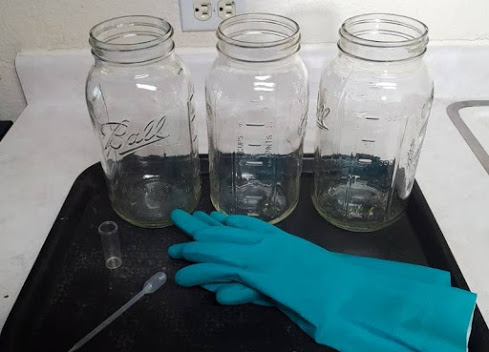
The "collection vessels" will be used to capture your filtrates, perform recrystallizations, and make solutions. It is best to use glass...Tip: It's better to go a little bigger on the vessels than to go too small. It's also better to have a few than to have just a couple. A small vial and pipette can be used to collect samples for testing as well.
THE COOKING VESSEL:
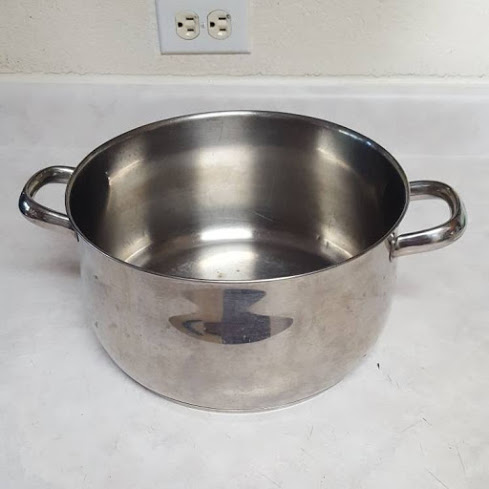
The cooking vessel should be stainless steel or other non-reactive cooking material... and again go bigger than you think you'll need.
FILTRATION:
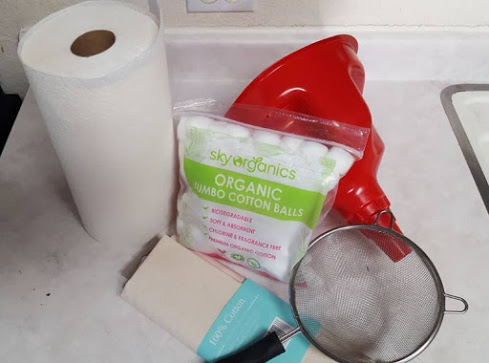
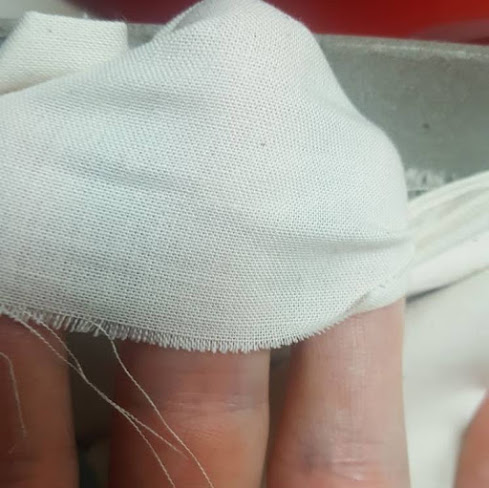
Proper filtration is a big part of making a clean harmalas extract and can be a real pain.....but the filtration method in this TEK makes it easy while still producing a plant matter free extract. here's what is used: 1.Strainer(to strain the seeds) 2.Cotton balls(for initial filtering to remove large particles from tea and is an optional step) 3.Cotton cloth(to remove finer particles from tea and to also capture harmalas precipitates) 4.Paper towels(we will be making a filter out of these for the remaining ultra fine particles) 5.Large funnel(again bigger is better)
STARTING PLANT MATERIAL:
-WHOLE Syrian rue seeds Harmalas are readily extracted from whole seeds. Powdered seeds are a headache to filter and honestly I don't see an advantage to using them. I've never gotten a bigger yield, nor is it any easier to exhaust the seeds of its harmalas...IME.
PROCEDURE PREVEIW:
Now that we have all the things we need for this TEK let's do a quick rundown of the steps:
1. Making the tea- To make the tea we will be steeping the whole seeds in slightly acidic and near boiling water. The harmalas will dissolve into the water.
2.Extracting the harmalas by freebasing- After the tea is made a sodium carbonate solution is added and freebase harmalas will crystalize out of solution. This is then collected.
3. Dissolving the harmalas- The freebase harmalas are then dissolved into vinegar and water.
4.Filtering harmalas solution- The harmalas solution is filtered to remove all plant matter.
5. Purifying by recrystalizaton- Both freebasing and the manske technique are used to recrystallize the harmine and harmaline several times to obtain cleaner specimens.
6. Separating harmine from harmaline- Harmine freebase precipitates out of solution at a lower PH than harmaline. We'll be taking advantage of this.
7.Final manske(optional)- A final manske can be done and washed with water to remove excess salts for a clean HCL salt.
THE PROCEDURE:
1. MAKING THE TEA
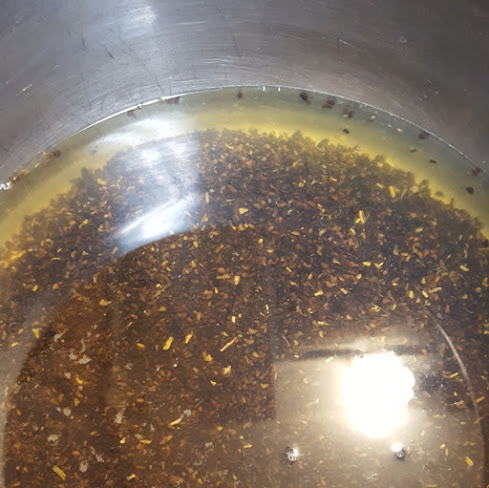
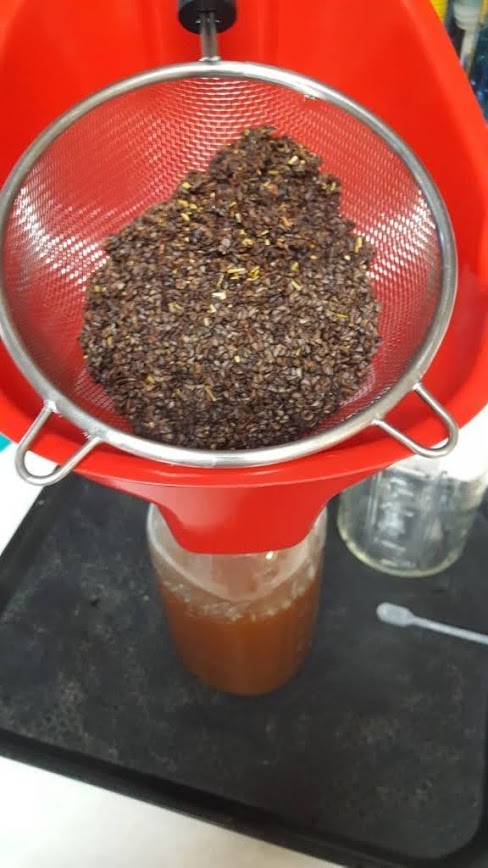
Our goal for the tea phase is to remove the water soluble alkaloids from the seeds using hot and slightly acidic water. Know that it'll take about 0.5-1 gallon of water total for every 100 grams of seeds you want to extract and at least four separate boils on those seeds to get all the harmalas out. (Distilled water is not necessary until the final recrystallizations are performed)
1. Place your seeds in the large pot and cover with enough water so that the water level is twice that of the seeds(keep in mind that similar to cooking grains rue seeds will absorb some of your water in the first boil)
2. Add just a dash of vinegar to acidify your water. This helps to make the harmalas more soluble.
3. Bring your pot to a low boil and stir occasionally.
4. Once you notice the color of your tea is not getting any darker indicating full saturation...it's time to strain the tea from the seeds....
-4a.Set up the strainer over a collection vessel to catch your tea as depicted above(I'm using a small strainer over a funnel that leads into a jar).
-4b. Grab your pot containing the tea and seeds and pour the contents carefully into the strainer and allow the tea to fall away from the seeds.
5. Return the seeds to the pot and repeat steps 1-5 until the tea maintains a light yellow color despite a long steep time. This is a good indicator that the seeds are exhausted of the target harmalas. To make sure you've got it all you can take a small sample of this last tea pull and add a sodium carbonate solution until you reach a PH of at least 10. If you're not using a PH indicator add sodium carbonate solution until it smells...well... fishy. Excess base will not cause issues in this step, so no stress. If your tea turns milky or you see anything precipitate it means that there is still more alkaloids in the seeds and another boil is in order.
2. EXTRACTING THE HARMALAS BY FREEBASING
Now it is time to do the first recrystallization by raising the PH of our tea. This step and step 3 are done mostly to aid in the filtration step by reducing the total volume of the mother solution, but also serve to increase purity of the harmine and harmaline.
1. Slowly add a sodium carbonate solution to your tea while stirring until a PH of at least 10 is reached. For folks not using PH indicators add your base solution until no more color change is noticed. Your tea should turn from orange/yellow to a milky tan. This is because microscopic crystals are forming in the solution! Be cautious of the base reacting with the acid and alkaloids in the tea as it can bubble out of control! For this reason its good to have larger than necessary collection vessels.
2. Now to separate the crystals from the liquid portion. You can immediately run your crystal slurry through a cloth filter or wait for the crystals to settle to the bottom. Waiting allows you to decant(carefully pour off) a lot of the liquid greatly reducing the volume that needs to be filtered. To make the filter setup simply drape a square of cloth over a funnel and place the funnel on top of a collection vessel. Once the crystals are collected the liquid can be discarded.
3. Place your crystals in a collection vessel and add enough water to allow the crystals to flow freely. Stir the crystals around in the water and pour it through a filter one more time. This is done to remove the remaining sodium carbonate. Again you can wait for the crystals to settle to decant the water if you wish. 4. Place the crystals in a collection vessel in anticipation for the next step.
3. DISSOLVING THE HARMALAS
By dissolving the crystals in an acidic solution we can obtain a concentrate that is much easier to filter than the initial tea would have been.
1. Again, being cautious of the solution bubbling over, slowly stir in vinegar to your freebase crystals until the harmalas fully dissolve and only dark brown solids remain. If the solution smells of vinegar(or is acidic for those using PH indicators), but has not dissolved all the alkaloids yet give it a little time, stir, and break up any large clumps of harmalas if present.
2. Once the alkaloids are fully dissolved allow the solution to sit undisturbed allowing the dark brown plant matter to settle to the bottom of your collection vessel.
4. FILTERING THE SOLUTION
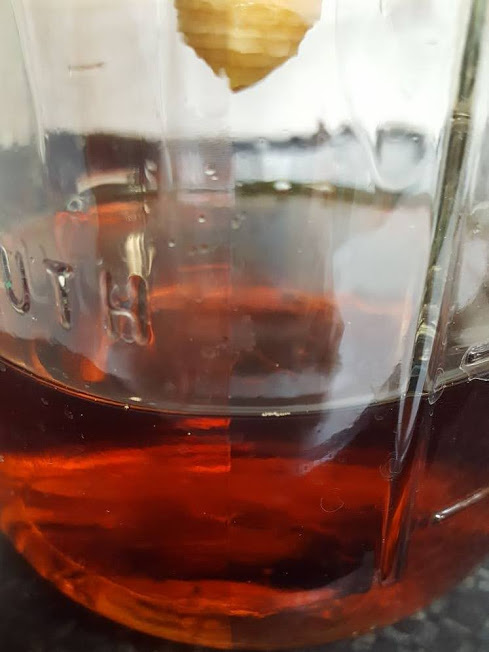
Filtering out the plant matter thoroughly is a vital step in making an impressive extract!
1. Set up a cloth filter just like in step 2.
2. Carefully and slowly, decant your solution into the filter apparatus, stopping as soon as you see the sediment trying to sneak its way out.
3. Once the solution has made its way through the filter, move the filter apparatus to a new collection vessel and dump the rest of the sediment laced solution in the filter. Keeping these two filtrates separate will help prevent clogging in the next, much finer, filtration step. Once it's through the filter add some water to wash any remaining solution from the sediment.
4. Now, we make a paper towel filter that's great for removing fine particles. This filter works by a combination of gravity, the wicking effect, and surface area. Its long length increases its effectiveness in all three of these areas. Here's how it's made:
4a- Fold in half and tightly roll up enough paper towels to fit fairly snuggly into your funnel. Then stuff some paper towel into the space between the filter and wall of the funnels bottom tube.
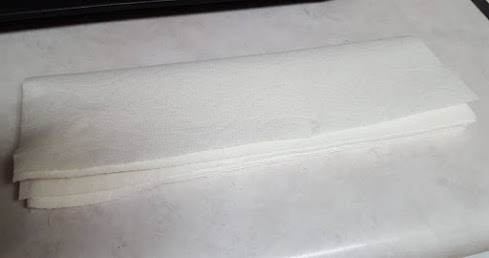
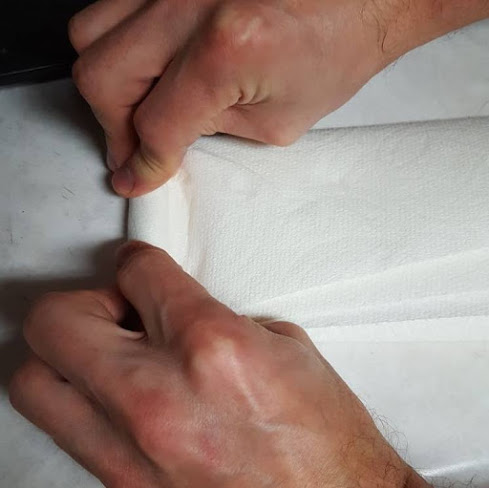
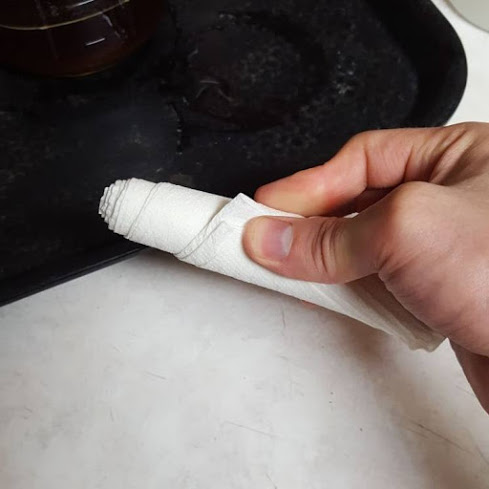
4b- Be sure that a good length of the rolled up paper towel is sticking out of the bottom of the funnel and the other end is sticking up inside the funnel. The portion sticking out helps to better draw the solution through, and the portion sticking up in the filter increases surface area for the solution to pass through.
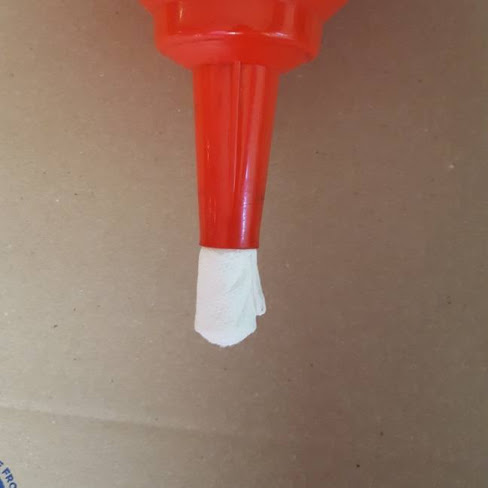
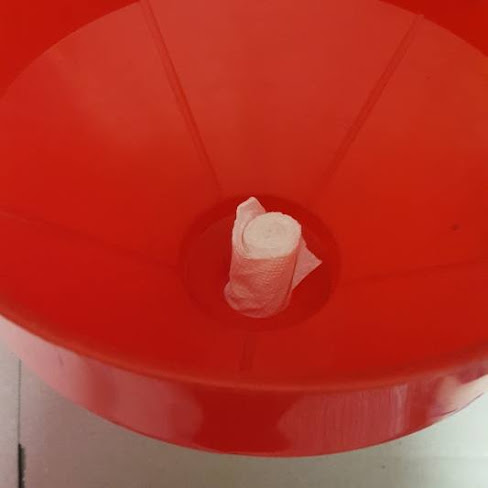
5. Run your cleaner filtrate through this filter first and the dirtier filtrate second. This will help speed things up. 6. Your collection vessel should now be filled with a sexy clean filtrate.
5. PURIFICATION THROUGH RECRYSTALLIZATION
Let's clean this up a bit! Your extract will become more and more pure with every recrystallization as more and more impurities get separated from the harmalas. We'll be using two techniques in this step: Freebasing, which we already did in step 2 and... the manske TEK.
5a.How to do a manske recrystallization

(Harmalas HCL after manske)
So, the manske works by adding salt to the harmalas solution forcing harmine and harmaline to crystallize. This occurs because harmalas is poorly soluble in salt water making a saline solution an excellent choice for recrystallization. Anyways, here's how it's done:
1. Super saturate water with salt by adding salt to boiling water until no more salt will dissolve into it. you'll want to use a volume of water that is at least 1/3 of your harmalas solution volume. *Supersaturation occurs when a solvent is holding more dissolved solids than its normally capable of at room temp. Usually, but not always. this is accomplished by heating the solution increasing a given chemicals solubility in said solvent.
2. While it's still hot, add the salt water you just made to your solution at a ratio of about 1:2-1:4(salt water: harmalas solution). Exact ratios aren't too important, but keep in mind the more salt water you add the faster it will crystallize causing the crystals to be smaller and less pure.
3. As it cools crystals will start to form. This is because cooling the solution decreases the amount of dissolved solids the water can hold forcing the less soluble alkaloids out. This will take anywhere from minutes to days depending on the initial concentration of alkaloids and the amount of salt used.
4. Once fully cool and no more crystals seem to be forming, run it through the cloth filter apparatus. Be sure to include a collection vessel to collect this filtrate as it typically still has a little harmine and harmaline in it that can be cleaned/recrystallized separately to recover the loss. It's kept separate because it's contaminated with the unwanted alkaloids that we just cleaned out!
5. When everything is filtered through, squeeze the excess solution out. There will always be some left over after squeezing and it is'nt necessary to remove all of it until your final manske. -When that time comes to remove the excess salt simply wash the crystals with a small amount of cold water. Some harmalas will dissolve into the water, so be sure to save it. A sodium carbonate solution can be added to this water to retrieve the would be lost harmalas in freebase form. (Harmalas HCL)
6. The resulting harmalas salts can then be dissolved in hot water and the process repeated to clean the extract further. I personally like to do 3 manskes, but you can do as many as you like.
5b. Recrystallizing by freebasing

(Freebase harmalas crystals precipitating)
Freebasing does not remove nearly the amount of impurities as a manske would, but it may be removing stuff that a manske can't.
1.Simply repeat step 2 to do a freebase recrystallization.
Again you can do it as many times as you like, but there may be a small loss in yields every time. *Keep in mind if you plan on moving on to the next step which shows you how to separate the harmine and harmaline that it involves more freebasing.* That's all that's too it as far as making a nice Syrian rue extract goes!
You now have a fairly pure mix of harmine and harmaline and can stop here, but by taking it a step further and separating the two, you will then know how much of each is present. If that sounds like something you'd want...advance to step 6! (If you would like to make a HCL salt just do another manske. To remove table salt contamination simply wash the HCL crystals in cold water and run through a filter with a collection vessel to catch the water. Some harmalas will dissolve into this water, so simply freebase to retrieve it from the water.)
6. SEPERATING HARMINE AND HARMALINE
Separating these two harmalas can be a bit of a pain....or pretty easy depending on how thorough you want to be.
6A. The harmine
First, we'll retrieve the harmine.
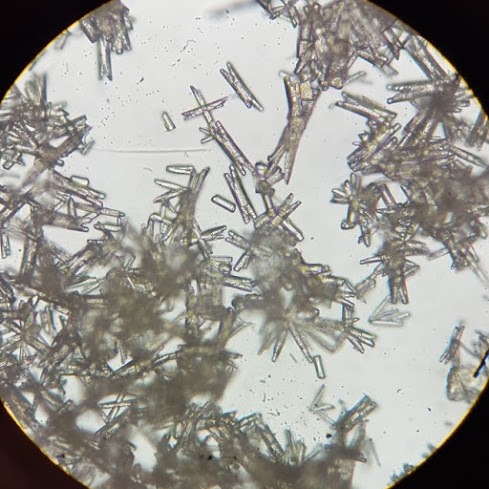
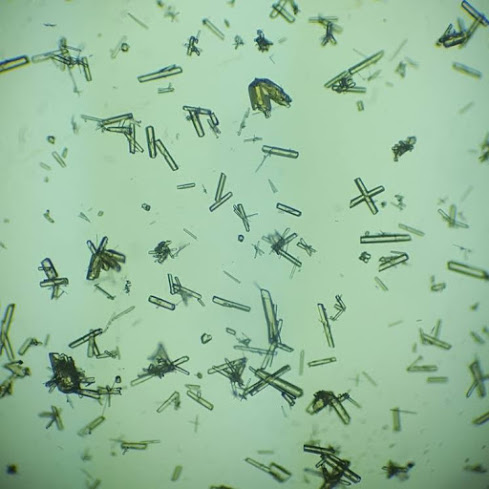
(Freebase harmine exhibiting different morphology)
1. You'll need to start with a harmalas Aquarius solution. If you have harmalas salts simply dissolve in warm water.... If you have freebase you'll need to dissolve it in acidified water(use the minimum amount of acid needed to convert the freebase into a salt)
2. Make a baking soda solution by adding baking soda to water until no more will dissolve.
3. While stirring add the baking soda solution to the harmalas solution slowly stopping as soon as you see crystals start to form. Its important to go slow to prevent as much harmaline from precipitating out as possible.
4. Let it chill until crystals stop forming.
5. Repeat steps 3-4 of this section until no more crystals form. Be careful as adding too much baking soda solution will cause harmalas salts to crystalize out of solution too(accidental manske). You'll know this has happened if the crystals are yellow and the abundancy of crystals is way more than anticipated. In this event the harmalas salts will re-dissolve when washed with water leaving behind your freebase harmine.
6. Set up the same filter apparatus with accompanying collection vessel we've been using and pour your crystals through. Once the liquid has separated from your crystals, wash very well with fresh water to remove the remaining solution. DO NOT THROW AWAY THE LIQIUD!! REMEMBER THE HARMALINE IS STILL IN THERE!!!
7. Squeeze all the water out. You can stop here as your harmine is now reasonably separated from the harmaline, but by re-dissolving in acidified water and repeating steps 3- 7 from this section a few more times, it will be pure enough to glow blue under black light! (To check your progress dip a Q-Tip in the harmine solution and then the now harmalas soaked Q-Tip in a volume of clean water all while viewing under a black light. If it glows greenish, give it another round of separation...If its glowing blue, this indicates that very little to no harmaline is present!)
6B. The harmaline
To retrieve the harmaline we'll now need to use sodium carbonate to drive the PH up higher.
THIS MUST BE DONE -AFTER- REMOVING THE HARMINE!
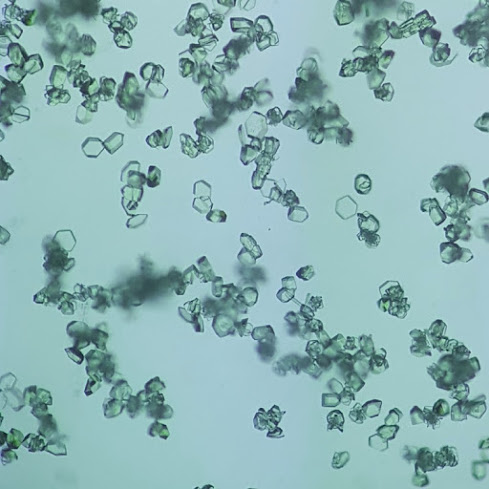
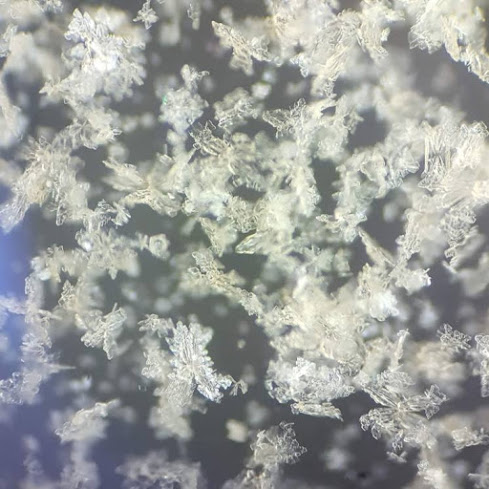
(Freebase harmaline exhibiting different morphology)
1. Make a sodium carbonate solution by adding sodium carbonate to water until no more will dissolve.
2. While stirring your harmaline solution slowly add the sodium carbonate until no more crystals form.
3. Set up that filter apparatus once again and collect your crystals.
4. Wash crystals with lots of clean water to remove any remaining solution.
That's it!
CONGRADULATIONS!
You should now have some superb Syrian rue extract on your hands!
